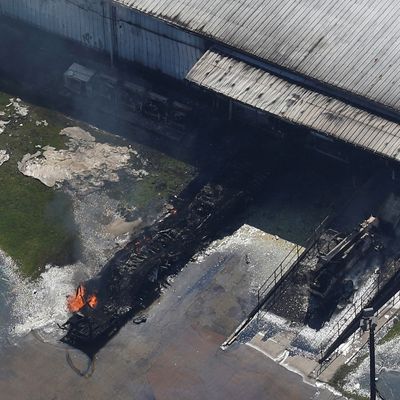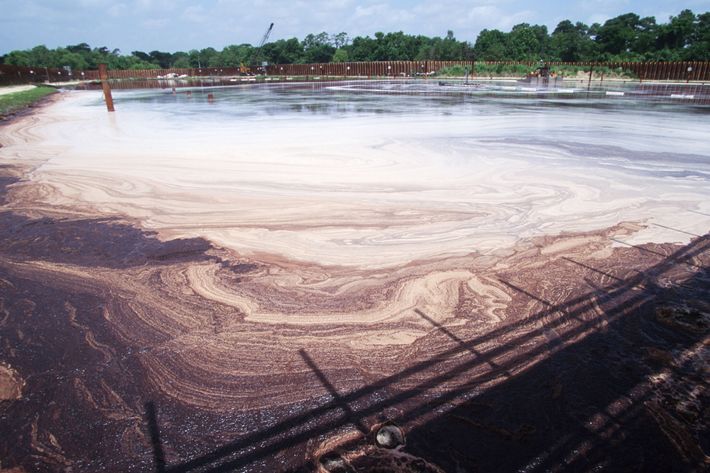
Harvey cleared out of Houston by midweek. But even as the skies cleared and floodwaters dipped down, the storm’s devastation continued to unfold. On early Thursday morning, two explosions erupted at the Arkema chemical plant in Crosby, Texas. Flames and thick black smoke whirled up from the wreckage, and at least 15 police officers and responders had to be treated for smoke inhalation. The company said it was virtually certain that more explosions were imminent. The highly combustible organic peroxides stored there needed to be kept chilled, but Harvey’s floodwaters had deluged the facility with six feet of water, cutting out the electricity, and then power to the backup generators, and, finally, knocked out all but one of the backup-backup refrigeration units on site.
Arkema executives said employees wouldn’t be able to return to the facility for at least a few days, as the fires burned out and floodwaters receded. The skeleton crew of employees who were still there left the site as soon as they realized explosions were inevitable. Residents within 1.5 miles of the Crosby facility, which is about 30 miles northeast of Houston, evacuated and have been told to stay away from the site. “It’s not a chemical release that’s happening and I want to be clear about that,” Arkema executive Richard Rennard said. “What we have is a fire.” He did call the smoke “noxious,” but declined to say whether it was toxic. The Environmental Protection Agency has said there are “no concentrations of concern for toxic materials,” but is continuing to monitor the air quality around the plant. It also urged people to stay indoors, with their windows closed.
Arkema’s owners had protested an Obama-era regulation — which the Trump administration had, this week, delayed anyway until 2019 — that would have tightened safety regulations on plants that handle certain chemicals. The organic peroxides, used in plastics manufacturing and in other products, that caused the explosion wouldn’t have been covered under that rule, but other chemicals within the plant, including isobutylene or sulfur dioxide, would have been — and experts say first responders should at least be aware of which other toxic substances are stored on site. Arkema officials said it did not believe the fire would affect the other compounds at the facility. If it did, it would be catastrophic: Reuters reports that the company’s 2014 EPA risk-management plan said such a situation could put up to one million people at risk, up to 23 miles away.
The U.S. Chemical Safety Board is investigating the explosions, and warned about the dangers of bringing the plant back online after flood damage. But Arkema is far from the only petrochemical plant or refinery that faces hazards as its employees survey the storm damage and begin resuming operations.
The Houston area is America’s petrochemical hub, with more than 450 plants, including dozens of refineries, which means literally billions of gallons of hazardous chemicals and fuels housed alongside millions of people in America’s fourth-largest city. Dozens of Superfund sites also dot the Gulf Coast, many of which may still be underwater.
Cleanup has barely begun in Houston, and other parts of East Texas and Louisiana are still battling dangerous floods as Harvey, now a tropical depression, cuts its way through Kentucky and Tennessee. The death toll has risen to at least 46, and tens of thousands are still taking refuge in shelters. The risks remain: bodies still to be uncovered, undrinkable water, the first mold spores taking hold. Now the environmental dangers loom, both in the air as plants leak out chemicals, and in what many toxins may have leached into the floodwaters that overtook hundreds and hundreds of first-floor carpets.
“I’d put it on the scale of 9/11 health risk,” James Norton, a former deputy assistant secretary at the Department of Homeland Security during the second Bush administration told Politico. “There was a similar challenge in Katrina, as the standing water around the city kind of became a chemical sludge. The risk in Houston is greater.”
So Arkema may be an outlier for its explosions, but it is not the only facility raising alarms. Chemical plants tend to release chemical emissions when they shut down or start up completely — which happened in dozens of facilities in the region this week. According to the advocacy group Environmental Defense Fund, Houston’s petrochemical industry released about one million tons of “harmful pollutants” into the air this week. People even complained of chemical smells in the Houston area:
Chevron Phillips flared (flaring is essentially burning gases) 766,000 pounds of chemicals. Releases occurred at ExxonMobil during a controlled shutdown at its Baytown facility on Sunday, which sent out some not-so-great-sounding chemicals into the atmosphere, including carbon monoxide and sulfur dioxide, reports PBS, though they did not exceed legal standards.
But two of ExxonMobil’s refineries were also damaged by Hurricane Harvey. A floating roof sank into a tank because of the heavy rains, releasing more fumes — this time unplanned. A sulfur thermal oxidizer was also damaged at an ExxonMobil facility in Beaumont, Texas. The plant sent out more than 1,300 pounds of sulfur dioxide, which exceeded its permit limits.
Also over the weekend, Harvey’s rains tipped over a 6.3-million-gallon fuel tank, spilling gasoline at pipeline company Kinder Morgan’s Pasadena Terminal. According to the Associated Press, a containment dike captured most of the spill. On Sunday, a lightning strike set two crude-oil storage tanks afire at the Karbuhn Oil Company in Harris County, which burned up two tanks and spilled about five barrels of crude oil. The site is across from a 25,000-acre protected wetland, says the Houston Chronicle.
More hazards lurk in the waters that still engulf the region, and in what will be left behind after the water dries up. Harris County, which includes Houston, has the most Superfund sites in the country, and experts are worried chemicals could have been absorbed and now pose serious health risks.

“There’s no need to test it,” a spokesman for the Houston Health Department told the New York Times, said about the floodwaters. “It’s contaminated. There’s millions of contaminants.”
That means poop. As you might have expected. But it also potentially means poisons like lead or benzene if water from contaminated sites seeps out. “If the water picks up contaminated sediment from sites, that may get deposited in areas where people frequent — residential properties, parks, ballfields — that were never contaminated before,” Nancy Loeb, the director of the Environmental Advocacy Center at Northwestern University Pritzker School of Law told the Washington Post. “We can’t say for sure it will happen, but it’s certainly a possibility.”
EPA officials reportedly traveled to Houston earlier this week to monitor risks across the area, and will be inspecting sites once the situation on the ground improves.
As devastating as Harvey is, and as devastating as it still could be, it probably could have been terrifyingly worse. Harvey slammed the Texas coast as a Category 4 storm — the most powerful hurricane to strike the United States in more than a decade. Its rains, and resulting floods were, as predicted, catastrophic. But it’s also worth nothing what didn’t happen, specifically storm surge. These plants are right on a coastline, and feet-high crashing waves could have brought untold environmental ruin — countless gallons of oil and chemicals spilled — and economic devastation, especially since they would destroy some of America’s busiest ports. (ProPublica’s report on this, pre-Harvey, will keep you up at night.)
Plans have been proposed — including one for an Ike Dike, a coastal barrier of dunes and gates to protect the Houston shipping channel and much of the “Chemical Coast” — but the Texas Gulf Coast remains as vulnerable as ever. Another storm will come, and when it does, the disaster will be unthinkable.





























